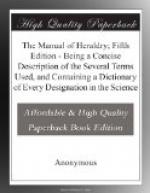[Illustration: Cotice]
Ex. Gules, a bend, argent, coticed of the same.
The riband, which is one third less than the garter and the bendlet, must never occupy more than one sixth of the field.
[Illustration: Riband]
Ex. Argent, a riband vert.
[Illustration: Bendlet]
Ex. Gules, two bendlets, engrailed, argent.
The bend sinister is the same breadth as the bend dexter, and is drawn from the sinister to the dexter side of the shield.
[Illustration: bend sinister]
Ex. Argent, a bend sinister, purpure.
The scarpe is the diminutive of the bend sinister, and is half its size.
[Illustration: scarpe]
Ex. Argent, a scarpe, purpure.
The baton is the fourth part of the bend, and, as before mentioned, it is a mark of illegitimacy, and seldom used in Heraldry, but by the illegitimate descendants of royalty.
[Illustration: baton]
Ex. Gules, a baton, sable, garnished, or.
THE FESS AND BAR.
The fess is formed by two horizontal lines drawn above and below the centre of the shield. The fess contains in breadth one third of the field.
[Illustration: fess]
Ex. Argent, a fess, azure.
The bar is formed in the same manner as the fess, but it only occupies the fifth part of the field. It differs from the fess, that ordinary being always placed in the centre of the field; but the bar may be placed in any part of it, and there may be more than one bar in an escutcheon.
[Illustration: Bar]
Ex. Gules, two bars, argent.
The closet is a diminutive of the bar, and is half its width.
[Illustration: Closet]
Ex. Argent, two closets, azure.
The barrulet is half the width of the closet.
[Illustration: Barrulet]
Ex. Gules, two barrulets, argent.
The annexed example is to illustrate the word gemels, which is frequently used to describe double bars. The word gemels is a corruption of the French word jumelles, which signifies double.
[Illustration: Gemels]
Ex. Azure, two bars, gemels, argent.
When the shield contains a number of bars of metal and colour alternate, exceeding five, it is called barry of so many pieces, expressing their numbers.
[Illustration: Barry]
Ex. Barry of seven pieces, argent and azure.
THE CHEVRON.
The figure of the chevron has been described as representing the gable of a roof. It is a very ancient ordinary, and the less it is charged with other figures the more ancient and honourable it appears.
[Illustration: Chevron]




